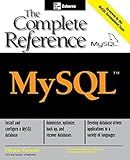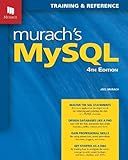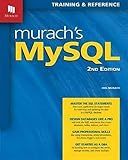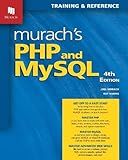Best MySQL Reference Books to Buy in October 2025

MySQL Commands Cheat Sheet Reference Guide – Beginner to Advanced | Essential MySQL Commands for Database Management



MySQL(TM): The Complete Reference



Murach's MySQL (4th Edition)



Murach's MySQL: Training & Reference



SQL Pocket Guide: A Guide to SQL Usage



Mysql Administrator's Guide an dLanguage Reference



MySQL Language Reference: The Official Guide to the MySQL Language and APIs
- QUALITY ASSURANCE: EACH BOOK IS THOROUGHLY INSPECTED FOR QUALITY.
- AFFORDABLE PRICES: SAVE MONEY WHILE ENJOYING GREAT READS.
- ECO-FRIENDLY CHOICE: SUPPORT SUSTAINABILITY BY BUYING USED BOOKS.



MySQL Cheat Sheet, Cover all Basic MySQL Syntaxes, Quick Reference Guide by Examples: MySQL Programming Syntax Book, Syntax Table & Chart, Quick Study Workbook (Cheat Sheet Series)



Murach's PHP and MySQL (4th Edition)


Aggregate functions in MySQL are used to perform calculations on sets of values and return a single value as a result. Some common aggregate functions include SUM, AVG, COUNT, MIN, and MAX.
To use aggregate functions in MySQL, you need to specify the function along with the column name or expression that you want to perform the calculation on. For example, to find the total sum of a column named "price" in a table named "products", you can use the SUM function like this:
SELECT SUM(price) FROM products;
This will calculate the sum of all the values in the "price" column and return the result as a single value. Similarly, you can use the AVG function to calculate the average of a set of values, the COUNT function to count the number of rows that meet a certain condition, and so on.
Aggregate functions are often used in conjunction with the GROUP BY clause to perform aggregate calculations on groups of rows based on a specific column or expression. This allows you to generate summary information on subsets of data within a table.
Overall, aggregate functions are powerful tools in MySQL that allow you to perform a wide range of calculations and analysis on your data.
How to optimize queries using aggregate functions in MySQL?
- Use indexes: Adding indexes to columns used in aggregate functions can significantly improve query performance. Indexes allow MySQL to quickly locate the relevant rows without having to scan the entire table.
- Limit the result set: Use the LIMIT clause to restrict the number of records returned by the query. This can reduce the amount of data that needs to be processed by the aggregate function, leading to faster performance.
- Use proper data types: Make sure that the columns used in aggregate functions have the appropriate data types. Using the correct data types can improve query performance and prevent unnecessary conversions.
- Use subqueries: Break down complex queries into smaller subqueries to optimize performance. Subqueries can help reduce the amount of data that needs to be processed by the aggregate function.
- Avoid using functions in the WHERE clause: Avoid using functions in the WHERE clause as this can prevent MySQL from using indexes efficiently. Instead, consider calculating the result of the function before filtering the data.
- Optimize the GROUP BY clause: Make sure that the GROUP BY clause only includes the necessary columns. Avoid grouping by columns that are not needed for the result set.
- Use EXPLAIN to analyze query performance: Use the EXPLAIN statement to analyze how MySQL is executing the query and identify any performance bottlenecks. This can help you identify areas where optimizations can be made.
- Tune the MySQL server configuration: Adjusting the MySQL server configuration settings, such as increasing the buffer pool size or adjusting the query cache settings, can also help improve the performance of queries using aggregate functions.
What is the difference between the AVG and MEAN functions in MySQL?
In MySQL, the AVG function is used to calculate the average of a set of values, while the MEAN function is not a built-in function in MySQL. The AVG function can be used with the SELECT statement to calculate the average of a column or a set of columns in a table. The MEAN function, on the other hand, is not a standard SQL function and would need to be defined and implemented by the user if needed.
What is the role of user-defined aggregate functions in MySQL?
User-defined aggregate functions in MySQL allow users to create their own custom aggregate functions to perform operations on grouped data. This allows for more flexibility and customization in data processing and analysis. These functions can be used in SQL queries just like built-in aggregate functions such as SUM, AVG, COUNT, etc. They can be particularly useful when specific business logic or calculations are needed that are not provided by the standard aggregate functions.
What is the use of the OVER clause with aggregate functions in MySQL?
The OVER clause with aggregate functions in MySQL is used to calculate aggregate values based on partitions defined by the OVER clause. This allows you to perform aggregate functions over a specific window of data, rather than the entire dataset.
For example, you can use the OVER clause to calculate the average salary within each department, or to calculate the cumulative total of sales for each month.
Overall, the OVER clause allows you to perform more complex and specialized aggregate calculations on subsets of data within your query.
How to find the sum of all values in a column using the SUM function in MySQL?
To find the sum of all values in a column using the SUM function in MySQL, you can use the following query:
SELECT SUM(column_name) FROM table_name;
Replace column_name with the name of the column you want to find the sum of and table_name with the name of the table where the column is located.
For example, if you have a table called sales with a column called amount, you can find the sum of all values in the amount column using the following query:
SELECT SUM(amount) FROM sales;
This query will return the sum of all values in the amount column of the sales table.
How to exclude NULL values from calculations when using aggregate functions in MySQL?
To exclude NULL values from calculations when using aggregate functions in MySQL, you can use the IFNULL function to replace NULL values with a default value before performing your aggregation.
For example, if you have a table sales with columns amount and quantity and you want to calculate the average amount of sales excluding NULL values, you can use the following query:
SELECT AVG(IFNULL(amount, 0)) AS avg_amount FROM sales;
This query replaces NULL values in the amount column with 0 before calculating the average. You can apply the same logic to other aggregate functions like SUM, COUNT, and MIN/MAX to exclude NULL values from your calculations.
